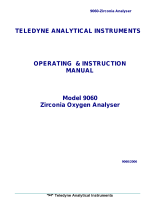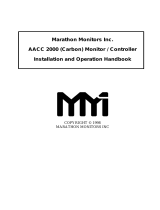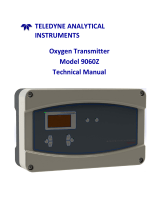Page is loading ...

Installation and Operation Handbook Supplement Zirconia Controller
Issue 1 April 1997 Applies to 2408 and 2404 controller software version 2.04 B-1
APPENDIX B ZIRCONIA CONTROLLER
This chapter has two topics:
INTRODUCTION AND EXAMPLES OF APPLICATION
MODIFICATION OF CONFIGURATION AND OPERATING MODES NAVIGATION
DIAGRAMS
INTRODUCTION
2400 series zirconia controller offers the opportunity to control the atmosphere of a heat
treatment process. In addition to the measurement of level of carbon (carbon potential) or
oxygen composition within the furnace, series 2400 zirconia controller also provides
dewpoint measurement, provided hydrogen concentration is known, using a standard zirconia
probe. Typical application areas are:
carburising steel
ceramics
Zirconia ZrO
2
sensors are designed for measuring the carbon potential in a furnace, where the
operating temperature is above 600
o
C, typical operating temperature is 600 - 1100
o
C. This
zirconia probe is a sandwich of zirconia (zirconium oxide) between two metal electrodes with
one side opened to reference air of a known composition . Some zirconia probes are fitted
with a thermocouple to give the process temperature at the probe tip. The zirconia probe will
output 0.0 - 1.5 volts depending on the probe temperature. The normal operating voltage for
carbon potential measurement is 1.0 to 1.3 volts.
Sooting Alarm
The airways in zirconia probes are prone to sooting due to the dirt and fumes present in the
furnace atmosphere. The resulting building up of deposits of the zirconia cell can cause the
probe to give an inaccurate reading and can damage the furnace and the load being treated.
Series 2400 zirconia controller provides an alarm if the level of soot deposits on the probe are
excessive. The calculation is defined by the probe manufacturers. It compares the carbon
potential calculated with deviation calculation based only on the probe mV signal. If the
calculated carbon potential falls outside the allowable band it indicates that the probe has
deteriorated outside its tolerance limits and the sooting alarm will be activated. The alarm is
only available for carbon potential measurement only.
If the controller detects an alarm condition, it will flash a message of "Soot" in the lower
readout of the Home display.

Installation and Operation Handbook Supplement Zirconia Controller
Issue 1 April 1997 Applies to 2408 and 2404 controller software version 2.04 B-2
Probe Cleaning(Purging)
To overcome the sooting problem, the probes are cleaned by forcing compressed air through
them at regular intervals, which burn off the soot deposits. Typically this is carried out every
four to eight hours during a firing cycle. Series 2400 zirconia controllers are equipped with
an probe cleaning algorithm which allows automatic or manual cleaning using a logic or relay
output.
While the oxygen probe is being cleaned, the controller will freeze the atmosphere PV during
the cleaning cycle and will only resume calculating the PV when the probe clean sequence
complete. The health condition of the probe is also monitored by comparing the time
required for the probe output returns to 95% of its previous value against a predefined
recovery time. If the actual recovery time exceeds the set recovery time, an alarm output will
be activated. This alarm is available for all zirconia function.
Sensor Break
The controller has two inputs
A High Impedance DC Input fit to Slot 3A.
A standard temperature input.
It is not possible to detect sensor break for the DC input. Hence the controller can only detect
sensor break for the standard temperature input. The controller will behave in the same way
as a standard controller if the temperature sensor is broken. Please refers to the standard
handbook for the details.
TYPICAL ZIRCONIA CONTROLLER CONNECTIONS
Typical hardware required by zirconia controller are:
Standard temperature input for probe temperature
DC Input Module installed in the Module 3 position for probe voltage input
DC Output Module of Dual Relay Module for control output
Standard Alarm Relay in AA for probe cleaning
Optional Dual Relay for Sooting Alarm and Probe Health Alarm
A typical wiring diagram is shown in Figure B-1.
MODIFICATION OF THE NAVIGATION DIAGRAM
The navigation diagrams for operating and configuration modes are modified. The changes
are highlighted in the Figure B-2 and Figure B-3.

Installation and Operation Handbook Supplement Zirconia Controller
Issue 1 April 1997 Applies to 2408 and 2404 controller software version 2.04 B-3
Figure B-1 Zirconia Controller typical connections
N
L
V+
VI
V-
Line
Neutral
Ground
PV
2D
2B
2A
2C
3D
3B
3A
3C
1D
1B
1A
1C
HF
HD
HE
C
O
M
M
S
1
JF
JD
JE
C
O
M
M
S
2
Common
Input 1
Input 2
85 to 264Vac
LC
LA
LB
AC
AA
AB
Self
Clean
l
Sooting Alarm relay
+ve
DC output
module
RTD/Pt100
HB
HA
HC
Probe Health Alarm relay
Zirconia Probe -ve
DC Input
module
Dual relay
output
module
+ve
-
ve
DC Control Output

Installation and Operation Handbook Supplement Zirconia Controller
Issue 1 April 1997 Applies to 2408 and 2404 controller software version 2.04 B-4
OPERATION MODE NAVIGATION DIAGRAM
Figure B-2 Modification Of Navigation diagram
PARAMETER TABLES
Name Description
Modbus
address
Zirconia Controller list
300
Reference Gas value.
307
Clean probe status ( or ).
It is possible to start and stop the clean
probe sequence manually. The Clean
probe sequence starts when is
switched from to . The sequence
stops and the auto clean timer resets
when is switched from to .
301
Auto probe clean switch, ( or ).
302
Time limit for probe recovery after
cleaning. Probe health status will set to
FALSE if actual recovery time exceeds
this limit, (in time unit hours).
303
Cleaning time in minutes
306
Time to next probe clean (in minutes).
304
Auto probe cleaning frequency (in hours).
305
Offset for Process Variable, e.g. %Carbon
Note:
The
List is present only in Zirconia controllers.

Installation and Operation Handbook Supplement Zirconia Controller
Issue 1 April 1997 Applies to 2408 and 2404 controller software version 2.04 B-5
CONFIGURATION MODE NAVIGATION DIAGRAM
(PART A)
Instrument Input Setpoint Alarms Programmer Logic inputs Alarm relay
Config
Config Config Config Config Config Config
Figure B-3a
Configuration Mode
Navigation Diagram (Part A)
PARAMETER TABLES
Name Description
Instrument list
(Modbus
address
650)
AACC Probe
Drayton Probe
Accucarb Probe
Marathon Probe
SSI Probe
Macdui Probe
Oxygen in %
Oxygen in Log’thm
unit
Dewpoint in Degree C
Dewpoint in Degree F
Alarm list
Probe health status
(Modbus address 308)
Probe clean valve
Sooting alarm
Extra items:

Installation and Operation Handbook Supplement Zirconia Controller
Issue 1 April 1997 Applies to 2408 and 2404 controller software version 2.04 B-6
CONFIGURATION MODE NAVIGATION DIAGRAM
(PART B)
Module 1 Module 2 Module 3 Calibration
Config
Config Config Config
Figure B-3b Configuration Mode Navigation Diagram (Part B)
Note:
1. Zirc.iP option is only available for dc.iP module fitted to 3A slot.
2. The values shown are the default seeting for a zirconia probe.
Input Voltage: 0-2000 mV
Input Range 0.0-2.0
/





